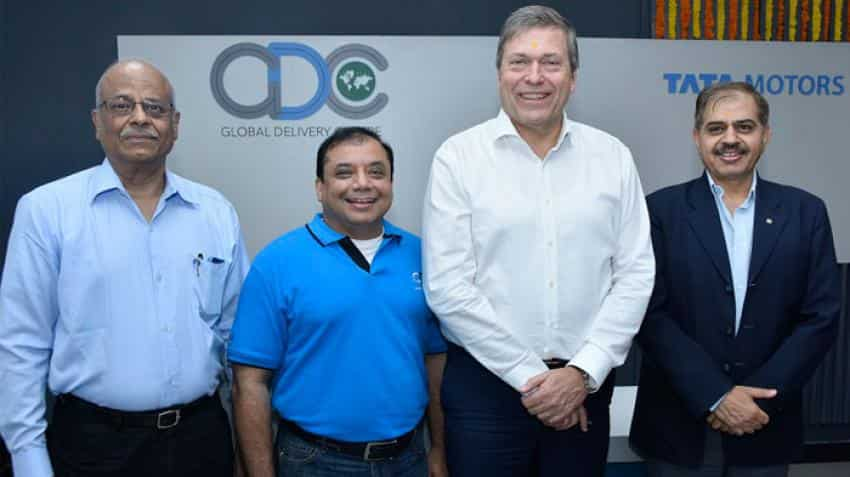Why Tata Motors' shares soar despite fall in Q4 net profits
Tata Motors' shares in early trade soared over 5% on BSE despite posting a 17% decline in net profits during Q4. So what is the reason for this huge gain in the stock? We take a look.

Key highlights:
- Tata Motors shares soared by nearly 5% and emerged as a top gainer on BSE
- Tata Motors Ltd reported a nearly 17% drop in its consolidated net profit
- Lower BS-III discounts had driven Tata Motors' margins
Tata Motors reported a 17% fall in its net profit on Tuesday evening and a 2.9% drop in consolidated revenues in Q4 Y17. However, the Indian automobile company's shares soared by nearly 5% and emerged as a top gainer on BSE in early trading on Wednesday. At 09:35 hours, Tata Motors was trading at Rs 466 per piece above Rs 16 or 3.53%.
Tata Motors Ltd reported a nearly 17% drop in its consolidated net profit at Rs 4,336.3 crore for fourth quarter ended March 31, 2017, as against net profit which stood at Rs 5,211.49 crore in Q4 FY16. Revenue was also down 2.9% at Rs 77,272 crore in Q4 from Rs 79,549 crore posted during the corresponding period of the previous year.
ALSO READ: Tata Motors' Q4 net profit slumps by 17%
So what is the reason for this positive momentum in Tata Motors stocks when the company has seen a decline in profits from corresponding quarter last year?
One of the reasons is that though Tata Motors net profit was down it had beat the Street's expectations. Financial analysts were expecting the company to post much more lower net profits and revenues during the quarter as a result of the impact of the Bharat Stage III emission ban by the Supreme Court. For instance, Motilal Oswal said that the Jaguar Land Rover (JLR) segment revenues was above their estimates.
It was not only that Tata Motors result's exceeded their expectations, the loss after tax too was above their expectations. While the Motilal Oswal report estimated that the loss after tax would be to the tune of Rs 700 crore, the adjusted loss after tax of Tata Motors was lower at Rs 540 crore.
The report says that lower BS-III discounts had driven Tata Motors' margins after the ban by Supreme Court. This resulted in loss of only Rs 150 crore for the pending BS-III inventory.
It was earlier estimated that Tata Motors along with Ashok Leyland and Mahindra & Mahindra has over Rs 5,000 crore of unsold BS-III inventory.
ALSO READ: Tata Motor, Ashok Leyland, Mahindra left with over Rs 5,000 crore of unsold BS III vehicles
Besides the lower impact of BS-III ban on the company, Tata Motors saw an improvement in its results due to the improved product mix and a price increase of about 3% taken in January 2017 which resulted in a higher Medium and Heavy Commercial Vehicles (MHCV) market share.
The company's realisation increased by about 5% to Rs 9,14,700 per unit in comparison to estimates of Rs 7,18,000 per unit, said the report.
ALSO READ: Tata Motors cuts up to 1,500 managerial jobs
While Tata Motors has been seeing a robust growth in its passenger vehicle segment, the MHCV segment of the company is expected to recover. The passenger vehicle segment grew by 23% on the back of incremental volumes of newly launched cars Tiago, Hexa and Tigor.
Tata Motors' management expects their MHCV market share to return to about 60% over the next two years from its current market share of 55-56%. It expects MHCV sales to be weak in the first half of FY18 while recovering in second half of FY18, whereas, in light commercial vehicle (LCV) segment the management expects a growth of 10% in FY18.
02:21 PM IST






 Tata Motors cuts up to 1,500 managerial jobs
Tata Motors cuts up to 1,500 managerial jobs Tata Motors' Q4 net profit slumps by 17%
Tata Motors' Q4 net profit slumps by 17%  Tata Motors Q4 preview: Margins likely to improve but questions remain on revenue growth
Tata Motors Q4 preview: Margins likely to improve but questions remain on revenue growth Tata Sons appoints Shuva Mandal as Group General Counsel
Tata Sons appoints Shuva Mandal as Group General Counsel Tata Motors' global sales decline by 4% in April
Tata Motors' global sales decline by 4% in April